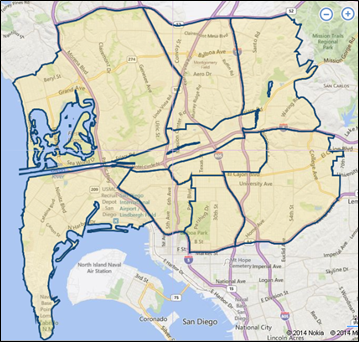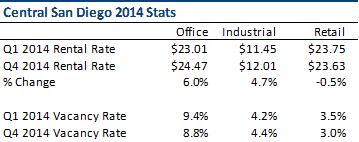2014 was a banner year for Meissner Jacquét and its commercial real estate management team. Besides maintaining a management portfolio totaling over 11.25 million square feet of office, retail, industrial and Commercial Owner Association properties throughout San Diego, Los Angeles, Orange, Riverside and Imperial Counties, and select areas in Arizona, Meissner Jacquét received notable awards from the Building Owners & Managers Association (BOMA) San Diego Chapter.
Each year BOMA San Diego holds a Winter TOBY and Membership Awards Gala where it recognizes members for their dedication and hard work to the commercial real estate organization.
The sixth annual Gala, held in December 2014, awarded 7 winners:
- Principal Member of the Year: Amber Molina of Colliers International
- Associate Member of the Year: Michele Ignacio of A.O. Reed & Co.
- Chairperson of the Year: Jessica Kalloch of Bill Howe Plumbing
- Rising Star: Dean Schumacher of Watkins Landmark Construction
- Gavel Award: Kristin Howell of Meissner Jacquét Commercial Real Estate Services
- President’s Award: Lynn Hulbert of Brandywine Realty Trust
- Champion of Education: Thor Emblem of ABM
“We are thrilled to have the opportunity to acknowledge the efforts and contributions of our incredible volunteers each year,” said BOMA San Diego President Kristin Howell of Meissner Jacquét Commercial Real Estate Services. “The success of our chapter relies heavily on our members’ commitment to the organization and each year we look forward to celebrating their dedication and passion to BOMA San Diego.”
In addition to going home with the Gavel Award, Meissner Jacquét’s property management team received several nominations. Senior Portfolio Manager Kristin Howell and Real Estate Manager Rhonda Vicker were nominated for BOMA San Diego’s Principal of the Year. Rhonda Vicker was also nominated for Chair Person of the Year.
BOMA members were not the only ones to bask in the spotlight. San Diego County commercial properties also received awards for The Outstanding Building of the Year (TOBY) 2014.
TOBY award winners included
- Less than 100,000 square feet
Canyon View Owners Association – 5330 Carroll Canyon Road, San Diego
Property Managers: Lyslie Brooks & Kristin Howell, Meissner Jacquét Commercial Real Estate Services
Owned By: Canyon View Owners Association
- 100,000 – 249,999 square feet
Nobel Executive Center – 3655 Nobel Drive, San Diego
Property Manager: BJ Van Aken, CBRE, Inc.
Owned By: Property Reserve Inc.
- 250,000 – 499,999 square feet
StoneCrest – 9635, 9645, 9655 and 9665 Granite Ridge Drive, San Diego
Property Managers: Mary Blagg & Katherine Cox, CBRE, Inc.
Owned by: TIAA-CREF
- 500,000 – 999,999 square feet
One America Plaza – 600 West Broadway, San Diego
Property Manager: Dan McCurdy, Irvine Company
Owned By: Irvine Company
- Suburban Low Rise (1 – 5 stories)
Kilroy Centre Del Mar – 3579, 3611, 3661, 3721 & 3811 Valley Centre Drive, San Diego
Property Manager: Bernadette Blanco, Kilroy Realty Corporation
Owned By: Kilroy Realty Corporation
- Suburban Mid Rise (6 – 10 stories)
San Diego Tech Center – 9605 Scranton Road, San Diego
Property Manager: Amy Lane, EdgeCore Real Estate Group
Owned By: Locale Advisors and Lionstone Investments
- Industrial Office Park
Biltmore Ocean View Hills – 6151 – 6529 Progressive Ave. & 6120 Business Center Ct., San Diego
Property Managers: Kristin Howell, Meissner Jacquét Commercial Real Estate Services
Owned By: Biltmore Ocean View Association
To read the full description of each 2014 TOBY Award Winner, visit San Diego Daily Transcript’s website.
“Meissner Jacquét’s participation and leadership role in BOMA San Diego allows us to have a direct impact on the commercial real estate industry. We place immense value on the relationships that we have with our vendors, clients, tenants and industry peers, and BOMA is a great platform to encourage these professional affiliations,” said Jerry Jacquet, a Principal at Meissner Jacquét Commercial Real Estate Services and a BOMA Advisory Board Member.
Sources:
Meissner Jacquét Commercial Real Estate Services
BOMA San Diego
San Diego Daily Transcript















